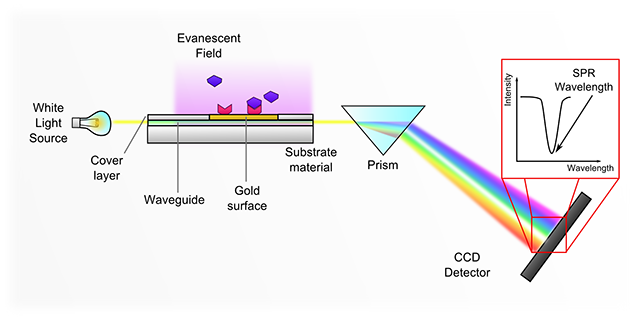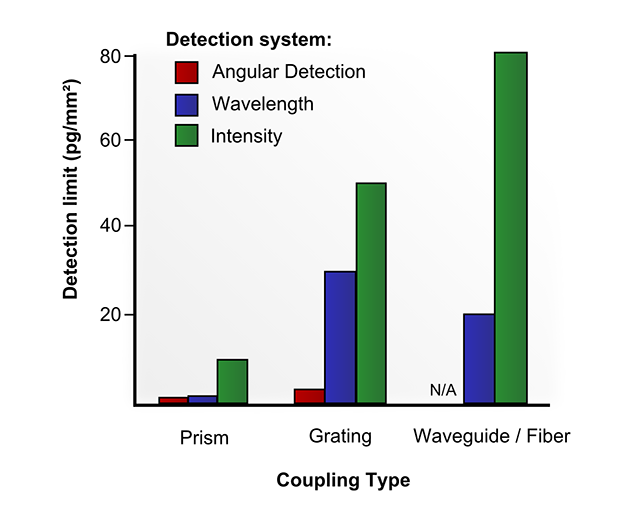Light falling on a metal surface is not, by itself, able to create surface plasmons – it must be coupled to the surface via a refractive device. This process allows the incident light to properly interact with the sensor chip, as well as focusing the reflected light towards a suitable detector system. Several differing approaches can be used to achieve this.
Prism couplers
Prism couplers are the most widely used form of SPR sensor configuration, in which light is coupled to the sensor chip via a prism underneath the chip substrate. The gap between chip and prism is bridged by a matching fluid of suitable refractive index, usually immersion oil or elastomers.
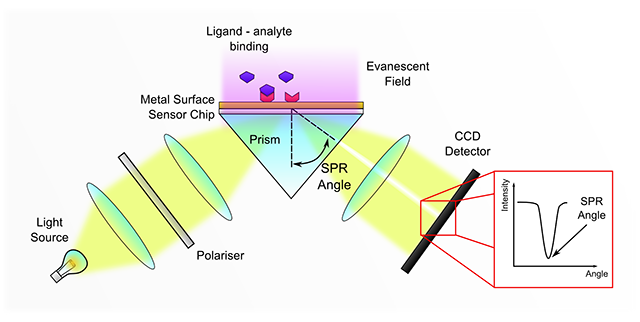
The figure shows a standard Kretschmann Configuration, which utilises a CCD/CMOS array to detect a wide angular range of reflected light. This configuration is robust, requiring a minimum of moving parts, and as such can be constructed in a compact manner. The wide range of simultaneous measurements also provides significant flexibility in experimental design. One disadvantage, however, is that the angular range that can be measured is usually fixed and difficult for users to alter. While the range (usually over 10 degrees) is large enough for almost all protocols, this can cause problems when needing to use less common experimental settings.
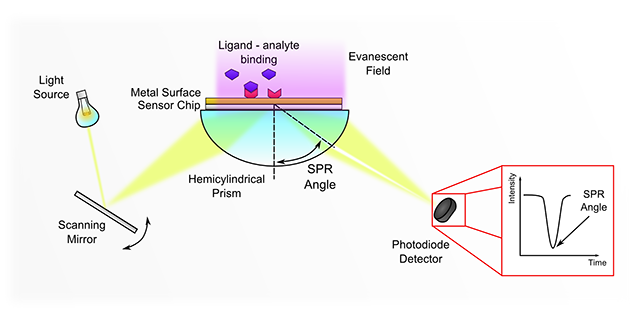
An alternative to the use of a CCD involves scanning optics. This system uses moveable mirrors to constantly adjust the angle of the incoming light, thus scanning across the entire field of possible reflective angles. As the focal point is constant, this system requires only a small photodiode rather than the larger, more expensive, CCD/CMOS arrays. This in turn means that scanning optic systems can be produced at lower prices.
Unfortunately, the smaller photodiodes usually lead to significantly higher noise levels, approximately 10-fold higher than comparable array systems. Furthermore, the requirement for precision moving parts in the mirror control apparatus means that these instruments require more regular servicing.
SPR Grating Couplers
The prism does not need to be directly coupled to the chip, as can be observed in grating couplers. Here the sensor chip substrate is embossed with a diffractive grating, this splits the incident light beam into a number of beams exiting at various angles. These beams can be further collated and split by prism sets, allowing the intensity of the spectra to be observed.
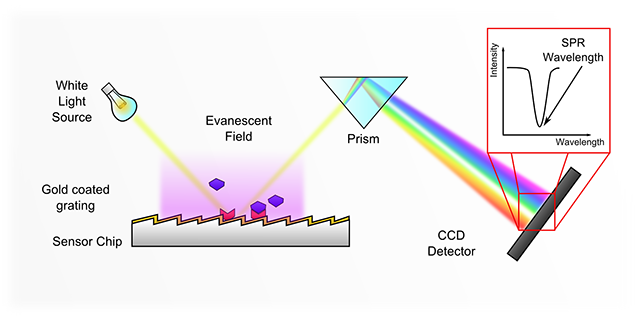
As the sensor chip is not directly coupled to a prism, the systems required for chip handling can be greatly simplified. This system also removes the requirement to precisely control the width of the plasmon-forming metal layer, although unfortunately the necessity of embossing the diffraction grating onto the chip does complicate the manufacturing process. Another important consideration is that, as the light must travel through the sample to reach the sensor chip, both analyte and buffer solution must be optically transparent.
Waveguides
The final method used in coupling light utilises a waveguide or optical fibre to transmit light perpendicular to the chip surface. Due to the simplicity of threading optical fibre these devices allow for extreme miniaturisation and siting in remote or inaccessible locations, and as such are of interest for production of monitoring systems. However, their small size leaves fibre optic systems very sensitive to mechanical disturbances. Similarly the cylindrical shape of fibre optics can lead to problems in the production process, particularly in fabricating homogenous metal coatings, or efficiently treating the surface with specific sensor molecules.
